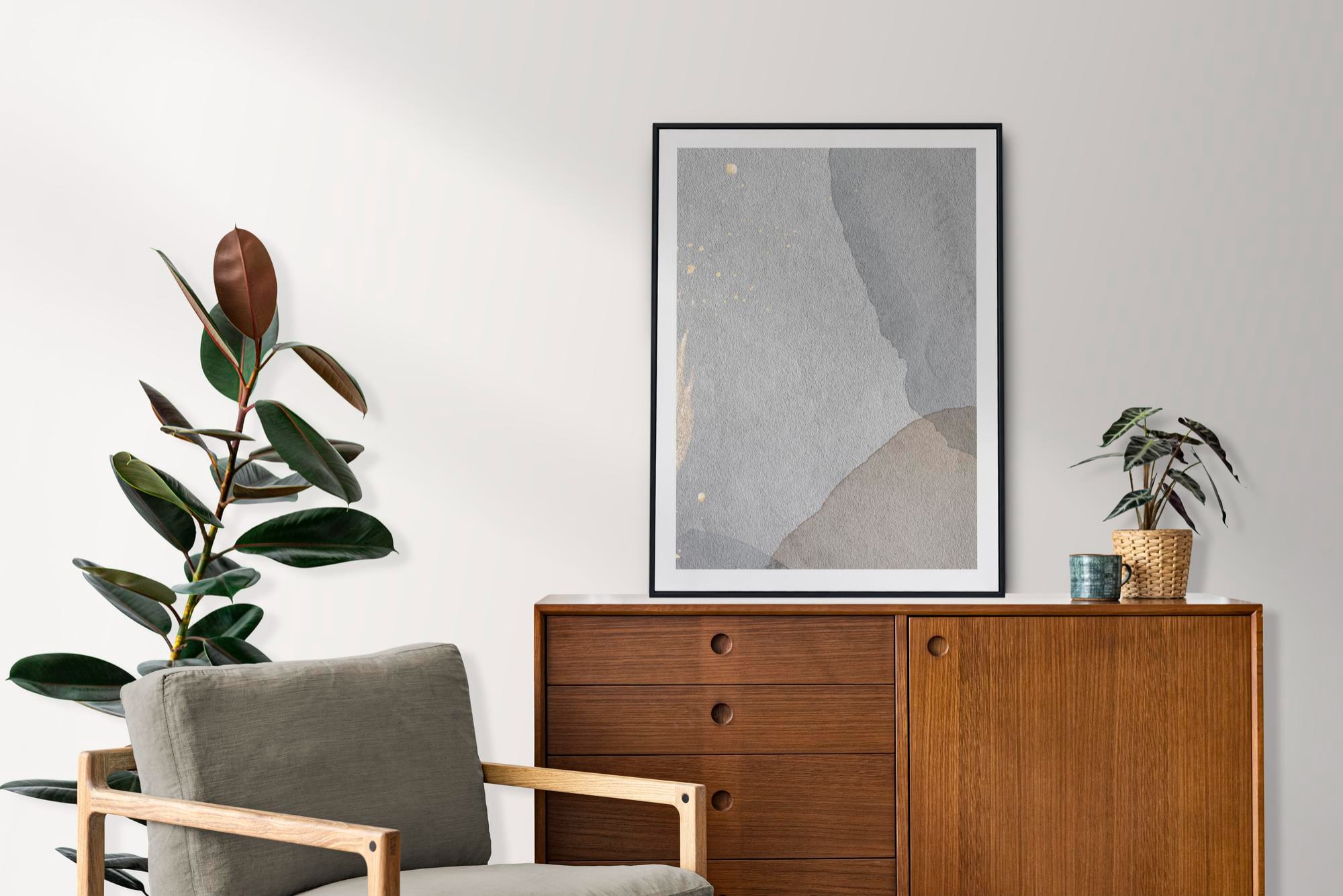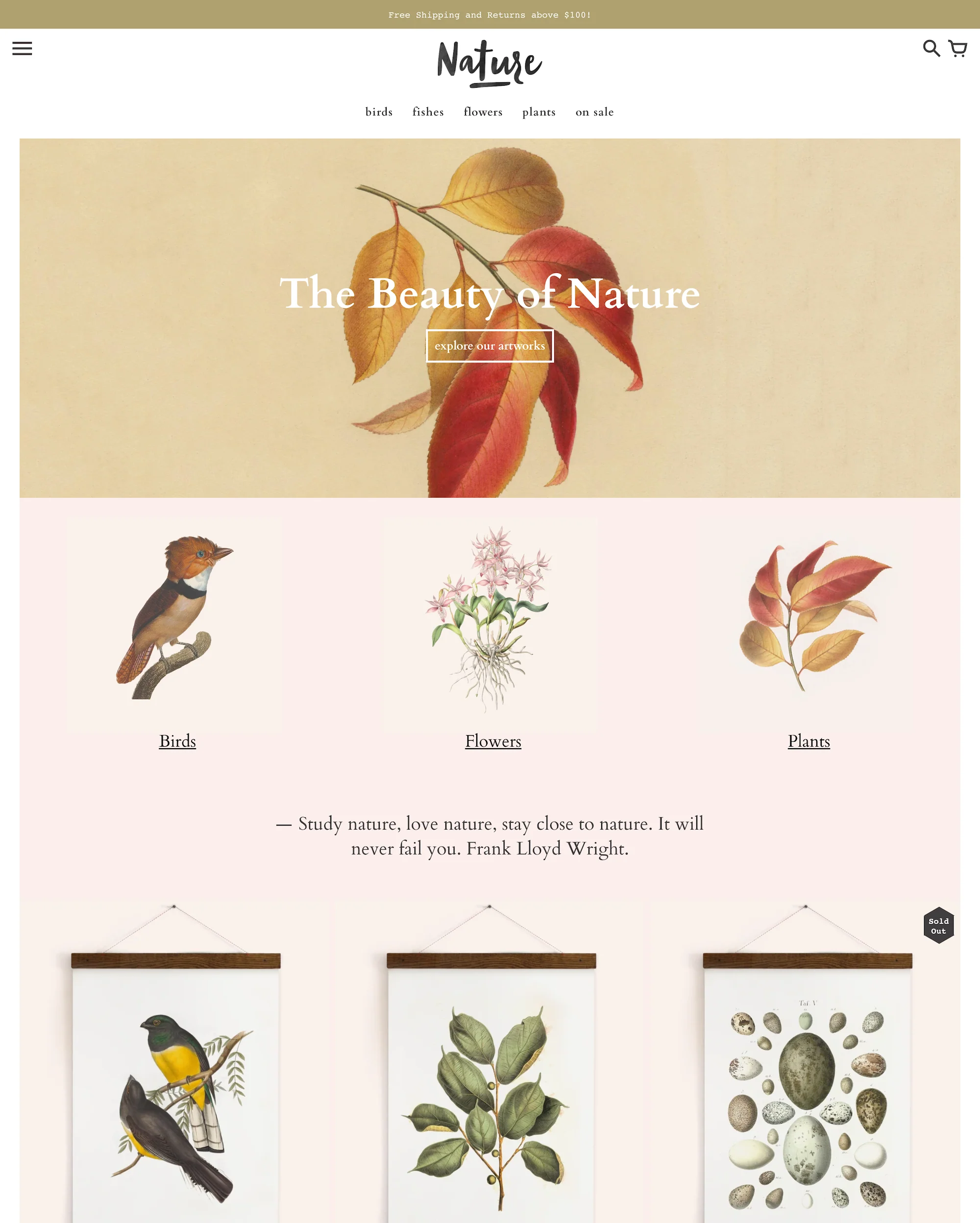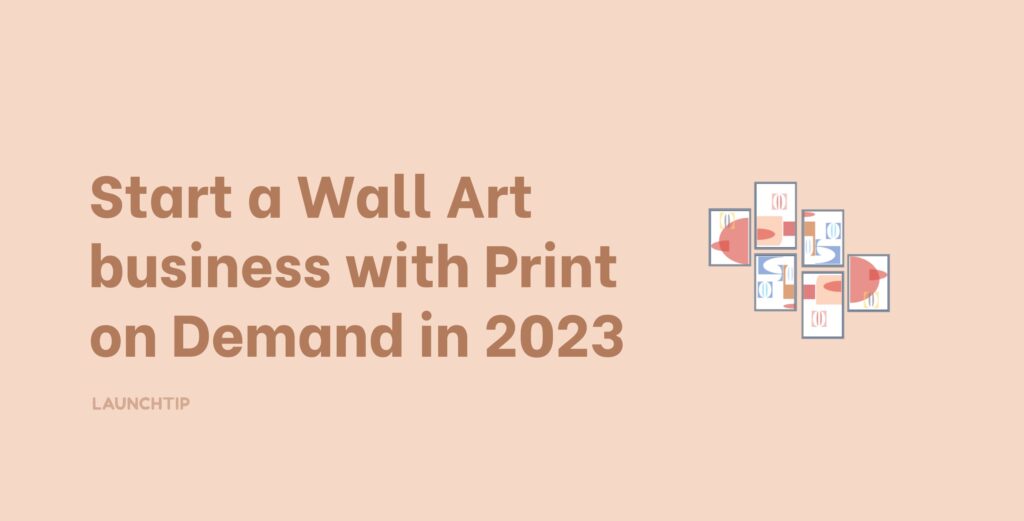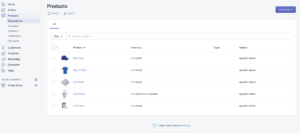Last Updated on by Dan S
Originally Published September 1, 2023.
Starting a wall art business that utilizes print on demand and Shopify is an excellent way to tap into the booming market for home decor while transforming your creative passion into a profitable venture. Here’s an in-depth, step-by-step guide to assist you in embarking on this exciting journey.

Table of Contents
ToggleStep 1: Research the Market
Begin by conducting thorough market research to lay a strong foundation for your business:
Competitive Analysis:
- Key Players: In-depth competitive analysis involves identifying the major players in the wall art market. These could be well-established art galleries, e-commerce stores, or independent artists. Analyze their market share, brand reputation, and customer base.
- Product Offerings: Examine the range of products offered by your competitors. Are they focused on a specific type of wall art, such as canvas prints or framed posters? Do they offer customization options or unique themes? Understanding their product catalog will help you identify gaps or areas where you can differentiate your offerings.
- Pricing Strategies: Investigate the pricing strategies employed by your competitors. Are they positioning themselves as premium brands with higher prices, or are they catering to budget-conscious customers with competitive pricing? Understanding their pricing models will inform your own pricing strategy.
- Marketing and Promotion: Explore how your competitors market their wall art products. Pay attention to their social media presence, email marketing campaigns, and partnerships with influencers or interior design blogs. This analysis will provide insights into effective marketing channels within the niche.
- Customer Reviews and Feedback: Read customer reviews and feedback on competitor products. This can reveal common pain points or areas where customers express dissatisfaction. Addressing these issues in your own offerings can give you a competitive edge.
- Unique Selling Proposition (USP): Identify what sets your competitors apart. Do they offer exclusive limited-edition prints, eco-friendly materials, or exceptional customer service? Determine how you can differentiate your brand and create a compelling USP.
Target Audience:
- Demographics: Define the demographic characteristics of your ideal customers. Consider factors such as age, gender, location, and income level. Understanding the demographics of your target audience helps tailor your marketing efforts.
- Interests and Hobbies: Delve into the interests and hobbies of your potential customers. For wall art, this could encompass art enthusiasts, interior design aficionados, nature lovers, or fans of specific themes (e.g., vintage, abstract, or pop culture). Align your product designs with these interests.
- Psychographics: Go beyond demographics and delve into psychographics. Understand the values, lifestyle, and aspirations of your audience. This insight allows you to create emotionally resonant marketing campaigns and product narratives.
- Problems and Needs: Identify the problems or unmet needs that your wall art can address. For instance, customers might seek wall art to enhance the ambiance of their homes, express their individuality, or support a cause. Tailor your messaging to showcase how your products fulfill these requirements.
- Purchase Behavior: Analyze the purchasing behavior of your target audience. Do they prefer online shopping or in-person art galleries? Are they price-sensitive or willing to invest in unique, high-quality pieces? Understanding these behaviors informs your sales and marketing strategies.
Trends and Demand:
- Artistic Styles: Stay attuned to the evolving artistic styles and themes that resonate with customers. This could include trends like minimalist designs, maximalist art, or eco-conscious artwork. Monitor art-related publications, blogs, and social media platforms for insights.
- Color Palettes: Pay attention to color trends in interior design and art. Certain colors and color combinations may become more popular in home decor, influencing your design choices.
- Sustainability: As environmental consciousness grows, consider incorporating eco-friendly materials and practices into your wall art production. Sustainable options can appeal to a niche of environmentally conscious consumers.
- Seasonal Trends: Be aware of seasonal demand fluctuations. For example, holiday-themed wall art may see increased interest during specific seasons. Plan your product releases and marketing campaigns accordingly.
- Customer Feedback: Continuously gather feedback from your customers and monitor their preferences. Conduct surveys, engage with them on social media, and encourage reviews. This feedback can help you adapt to changing trends and refine your product offerings.
- Emerging Technologies: Keep an eye on technological advancements, such as augmented reality (AR) for virtual art placement, which can enhance the customer experience and set your business apart.
By conducting a thorough competitive analysis, defining your target audience, and staying informed about trends and demand in the wall art market, you’ll be well-equipped to make informed decisions that drive the success of your print on demand and Shopify wall art business.
Step 2: Choose Your Niche
Once you understand the market, select a niche that aligns with your creative passions and customer preferences:
Passion-Driven Selection:
- Personal Connection: When selecting a niche for your wall art business, consider what personally resonates with you. What themes, styles, or subjects are you genuinely passionate about? Choosing a niche that aligns with your own interests will make your work more enjoyable and sustainable in the long run.
- Sustained Motivation: Building a business requires dedication and perseverance. When you are passionate about your niche, you’re more likely to stay motivated, especially during challenging times. Your enthusiasm can also be infectious and resonate with your customers.
- Creative Expression: Passion often fuels creativity. When you’re genuinely excited about the subject matter, you’re more likely to generate fresh and innovative ideas for your wall art designs. This creativity can set you apart in a competitive market.
- Expertise Development: Being passionate about your niche can lead to deep expertise. You’ll naturally immerse yourself in the subject, study its nuances, and develop a profound understanding of what appeals to enthusiasts within that niche.
- Authenticity: Passion shines through in your work. Customers can often sense the authenticity and dedication behind your creations, making them more likely to connect with and purchase your wall art.

Customer Appeal:
- Market Research: To understand what types of wall art resonate with your target audience, conduct thorough market research. This involves analyzing the preferences and buying habits of potential customers within your chosen niche.
- Audience Segmentation: Recognize that different customer segments may have distinct preferences. For example, abstract art might appeal to a younger, modern audience, while landscapes might attract nature enthusiasts. Segment your target audience to tailor your product offerings and marketing strategies effectively.
- Trend Analysis: Stay up-to-date with trends in wall art and interior design. Consumer preferences can shift over time, and being aware of these shifts allows you to adapt your product catalog to match current tastes.
- Customer Feedback: Engage with your audience to gather feedback on your designs and product ideas. Social media polls, surveys, and direct communication can provide valuable insights into what types of wall art they find most appealing.
- Seasonal Considerations: Some niches experience seasonal fluctuations in demand. For instance, holiday-themed art may be popular during specific times of the year. Be prepared to offer relevant products when these seasonal opportunities arise.
- Customization Options: Offer customization features that allow customers to personalize their wall art. This can broaden your appeal as customers seek unique pieces that align with their individual tastes and home decor.
- Collaborations and Partnerships: Explore collaborations with other businesses or artists who have a complementary target audience. These partnerships can introduce your wall art to a wider customer base.
- Customer Testimonials: Showcase customer testimonials and reviews that highlight how your wall art has enhanced their living spaces. These real-life stories can resonate with potential customers and build trust in your brand.
- Market Gaps: Identify gaps or underserved segments within your chosen niche. These gaps represent opportunities for you to create unique and appealing wall art that meets unmet needs.
By combining your personal passion with a deep understanding of your target audience’s preferences, you can select a niche and create wall art that not only excites you but also resonates with customers.
Step 3: Find a Print on Demand Provider
To sell print on demand wall art, partner with a reliable print on demand provider. Look for these essential attributes:
Quality Printing:
- Print Technology: Investigate the printing technology used by the provider. High-quality print results often come from modern, advanced printing techniques like giclee printing, which ensures accurate color reproduction and fine detail.
- Print Materials: Examine the materials the provider uses for printing. High-quality wall art typically involves archival-grade materials, such as acid-free paper for prints or museum-quality canvas for canvas prints. These materials ensure longevity and resistance to fading.
- Color Accuracy: Confirm that the provider maintains color accuracy. Wall art should reflect the true colors and details of the original artwork or design. Providers with color calibration processes can deliver consistent and accurate results.
- Sample Orders: Before committing to a provider, consider placing sample orders. This allows you to assess the print quality, color vibrancy, and overall craftsmanship. Ensure that the provider offers this option.
- Reviews and Recommendations: Research customer reviews and seek recommendations from other artists or businesses in your niche. Reliable print on demand providers often have a track record of producing high-quality prints.
- Testing and Quality Control: Inquire about the provider’s quality control processes. Ask how they ensure each print meets quality standards. Reputable providers have rigorous quality checks in place.
Product Variety:
- Canvas Prints: Canvas prints are a popular choice for wall art due to their texture and depth. Ensure your provider offers different canvas options, such as stretched canvas, gallery wraps, and various sizes.
- Posters: Posters offer an affordable yet visually appealing option. Look for providers that offer high-resolution poster printing with options for different paper finishes.
- Framed Art: Framed art adds sophistication to your product catalog. Providers should offer a range of frame styles and materials, allowing customers to customize their selections.
- Print Sizes: Variety in print sizes is essential to cater to diverse customer preferences. Ensure your provider offers both standard and custom sizing options.
- Additional Options: Consider other wall art options like metal prints, acrylic prints, wood prints, or wall decals. Offering a diverse range of products can attract a broader audience.
- Matting and Framing: If you’re offering prints, inquire about matting and framing options. These can enhance the overall presentation of your wall art.
- Accessories: Some providers may offer complementary products like hardware for hanging, wall art care kits, or certificates of authenticity for limited-edition prints. These extras can enhance the customer experience.
Efficient Turnaround:
- Production Times: Check the estimated production times provided by the print on demand provider. Efficient turnaround is crucial to meet customer expectations, especially if you advertise quick shipping.
- Order Tracking: Ensure that the provider offers order tracking capabilities. This allows you and your customers to monitor the progress of each order in real-time.
- Shipping Options: Assess the shipping options available. A variety of shipping choices, including express and international shipping, can expand your customer base.
- Shipping Locations: Confirm the locations to which the provider can ship. Global shipping capabilities can help you reach a wider audience.
- Order Management: Evaluate the provider’s order management system. A streamlined process, including automatic order fulfillment and tracking updates, can save you time and reduce errors.
- Customer Support: Inquire about the provider’s customer support availability. Timely and responsive support can be invaluable in resolving issues or answering questions.
- Return and Refund Policies: Understand the provider’s policies regarding returns and refunds. Clear policies and hassle-free return processes contribute to customer satisfaction.
Selecting a print on demand provider with a focus on quality printing, a diverse product range, and efficient order fulfillment is critical to delivering exceptional wall art products and meeting customer expectations. Research, sample orders, and thorough vetting are essential steps in finding the right partner for your print on demand and Shopify wall art business.
Step 4: Set Up Your Shopify Store
Create a professional and user-friendly Shopify store to showcase your wall art:
Domain Selection:
- Reflecting Brand Identity: Your domain name is a crucial part of your brand identity. Choose a name that is memorable, relevant to your niche, and aligns with your brand values. It should convey a sense of professionalism and credibility.
- Keyword Integration: If possible, include relevant keywords in your domain name. This can improve your store’s search engine visibility and make it easier for potential customers to find you.
- Simplicity and Memorability: Aim for a domain name that is easy to spell, pronounce, and remember. Avoid complex or lengthy names that might confuse or deter visitors.
- Domain Extensions: Consider using a domain extension that best suits your brand. While “.com” is the most common, there are various extensions like “.art,” “.design,” or even niche-specific extensions that can add uniqueness to your domain.
Design Theme:
- Consistency with Branding: Your chosen design theme should align with your brand’s visual identity. This includes color schemes, typography, and overall aesthetic. A cohesive design theme enhances brand recognition and trust.
- Showcasing Wall Art: The theme should allow you to prominently showcase your wall art products. Large, high-quality images and well-organized galleries can give customers a clear view of your offerings.
- Mobile Responsiveness: Ensure that your chosen design theme is fully responsive, meaning it works well and looks appealing on both desktop and mobile devices. A large portion of online shoppers use mobile devices, so a seamless mobile experience is crucial.
- User Experience: Prioritize user-friendly navigation. Customers should easily find product categories, search functionality, and a clear path to the checkout process.
- Load Time: Opt for a theme that is optimized for fast load times. Slow-loading pages can lead to high bounce rates and negatively impact your search engine rankings.
Payment and Shipping:
- Payment Gateway Integration: Integrate reputable payment gateways that cater to a wide range of customer preferences. Popular options include PayPal, Stripe, and credit card payments. Offering multiple payment methods enhances customer convenience.
- Secure Transactions: Ensure that your payment process is secure and encrypted to protect customer information. Display trust signals like SSL certificates to reassure customers about the safety of their data.
- Shipping Options: Provide customers with various shipping choices. This can include standard, expedited, and international shipping. Clearly communicate shipping costs and delivery timeframes at checkout.
- Shipping Policies: Clearly outline your shipping policies, including estimated delivery times, shipping fees, and international shipping information. Transparency in this area builds trust with customers.
- Tracking Information: Offer order tracking capabilities so customers can monitor the progress of their orders. This transparency enhances the overall shopping experience.
Optimization:
- Search Engine Optimization (SEO): Optimize your store for search engines to improve your visibility in search results. Use relevant keywords in product descriptions, titles, and meta tags. Write unique, compelling product descriptions that provide value to potential customers.
- High-Quality Images: Use high-resolution images that showcase the details of your wall art. Multiple images from different angles can help customers make informed purchasing decisions.
- Product Descriptions: Craft detailed and engaging product descriptions. Highlight the unique features of each piece and provide context that enhances the emotional connection customers might feel with your art.
- Meta Descriptions: Create compelling meta descriptions for each product and page. These brief snippets appear in search results and can influence whether a user clicks on your link.
- Structured Data: Implement structured data markup to provide search engines with additional information about your products. This can result in rich search results, known as “rich snippets,” which can improve click-through rates.
- Site Speed: Optimize your website’s speed by compressing images, minimizing code, and using content delivery networks (CDNs). A fast-loading site enhances user experience and can positively impact search engine rankings.
- Mobile-Friendly Design: Ensure that your Shopify store is fully responsive on mobile devices. Google’s search algorithm considers mobile-friendliness when ranking sites in mobile search results.
By paying careful attention to domain selection, design theme, payment and shipping options, and optimization strategies, you’ll create a user-friendly, visually appealing, and efficient Shopify store that effectively showcases your print on demand wall art and provides a seamless shopping experience for your customers.
Step 5: Create Your Designs
Now, unleash your creativity by crafting captivating wall art designs:
Artwork Portfolio:
- Curating Your Collection: Your artwork portfolio is the heart of your wall art business. Start by carefully curating the pieces you wish to feature in your store. Consider which pieces best represent your style and appeal to your target audience.
- High-Quality Scans or Images: Ensure that your existing artwork is captured with the highest possible quality. For physical artwork, this might involve professional scanning or photography to capture the intricate details, colors, and textures accurately.
- Digital Art Preparation: If you create digital artwork, make sure your files are in the highest resolution possible. The industry standard for printing is 300 DPI (dots per inch) for optimal results.
- File Formats: Verify that your artwork is saved in appropriate file formats. Common formats for printing include JPEG, TIFF, and PNG. Consult with your print on demand provider to ensure compatibility.
- Copyright and Licensing: If your artwork includes copyrighted elements, ensure you have the necessary permissions or licenses to use them in your wall art. Respect intellectual property rights to avoid legal issues.
- Consistency in Style: Maintain consistency in your art style to establish a recognizable brand identity. Cohesiveness in your portfolio helps build trust with customers and encourages repeat purchases.
Sample Designs:
- Market Testing: Creating sample designs is an excellent strategy for market testing. Develop a few distinct designs that represent different styles or themes within your niche. This allows you to gauge which designs resonate most with your audience.
- Gathering Feedback: Share your sample designs with a select group of individuals, such as friends, family, or social media followers. Encourage honest feedback regarding their preferences and impressions. This feedback can guide your design choices.
- Iterative Process: Understand that design is often an iterative process. Use the feedback received to refine your sample designs. This may involve making adjustments to color palettes, compositions, or other elements.
- Trend Awareness: While testing sample designs, pay attention to emerging trends in the wall art market. Trends can influence which styles or themes gain popularity, helping you adapt your designs to meet current demands.
- Design Variations: Consider creating variations of your sample designs. This allows you to offer diversity within a specific theme or style, catering to a broader range of customer preferences.
Quality Assurance:
- Print Provider Guidelines: Familiarize yourself with the specific design and file requirements of your chosen print on demand provider. Each provider may have unique specifications for file size, color profiles, and bleed areas.
- Color Accuracy: Ensure that your digital files accurately represent the colors of your artwork. Use color management techniques to maintain color consistency between your digital files and the printed results.
- Resolution Check: Verify that your digital files meet the recommended resolution (usually 300 DPI) for printing. Low-resolution files can result in pixelation or loss of detail in the final print.
- File Organization: Maintain organized file structures with clear naming conventions. This facilitates efficient management of your design assets, especially as your portfolio expands.
- Mockups and Previews: Before adding designs to your store, create mockups or previews of how they will appear on various wall art products. This helps you visualize the final product and ensures your designs are optimized for each product type.
- Test Orders: Consider placing test orders for your own products to inspect the print quality and color accuracy firsthand. This allows you to identify and address any issues before customers receive their orders.
- Feedback Loop: Establish a feedback loop with your print on demand provider. Maintain open communication to address any technical questions or concerns regarding your designs.
By maintaining a meticulously curated artwork portfolio, testing sample designs, and implementing rigorous quality assurance practices, you can confidently offer high-quality wall art that resonates with your target audience and meets the standards of your print on demand provider, enhancing the overall customer experience.
Step 6: Set Up Your Listings
Efficiently present your wall art products to potential customers:
Product Listings:
- High-Quality Images: The visual appeal of your wall art is crucial. Use high-resolution images that showcase your artwork in its full glory. Consider multiple images, including close-ups, to give customers a comprehensive view of the product. These images should be well-lit and accurately represent the colors and details of your art.
- Detailed Descriptions: Craft informative and engaging product descriptions. Explain the inspiration behind the artwork, the techniques used, and any unique features. Provide dimensions, materials, and care instructions if applicable. Use storytelling to create an emotional connection between the customer and the art.
- Product Titles: Create clear and concise product titles that accurately describe the artwork. Include relevant keywords to improve search engine optimization (SEO) and help potential customers find your products. For example, if you’re selling an abstract painting with vibrant colors, your title could be “Vibrant Abstract Canvas Painting – Modern Home Decor.”
- Pricing Strategy: Set competitive prices that reflect the value of your art while remaining competitive in the market. Consider factors such as production costs, your profit margin, and how your prices compare to similar products.
- Shipping Information: Clearly state shipping options, estimated delivery times, and associated costs. Transparency in shipping information builds trust with customers and reduces cart abandonment.
- Inventory Management: Keep your inventory up-to-date. If a particular product is temporarily out of stock, clearly indicate this on the product page and provide an estimated restocking date if possible.
- Collections and Categories: Organize your products into collections or categories based on themes, styles, or any other relevant criteria. This makes navigation easier for customers and encourages exploration of your catalog.
- Variants and Customization: If you offer variations of a product (e.g., different sizes or framing options), set up variants within the product listing. Additionally, if you allow customization, provide clear instructions on how customers can personalize their orders.
- Customer Reviews and Ratings: Encourage customers to leave reviews and ratings for your products. Positive reviews build trust and social proof, which can influence potential buyers. Respond to reviews, whether positive or negative, to demonstrate your commitment to customer satisfaction.
- Cross-Selling and Upselling: Suggest related or complementary products on each product page. For example, if someone is viewing a landscape painting, you could recommend matching framed prints or other artwork in a similar style.
Keyword Optimization:
- Keyword Research: Conduct keyword research to identify relevant search terms and phrases related to your wall art niche. Tools like Google Keyword Planner or third-party SEO software can assist in finding high-ranking keywords.
- Long-Tail Keywords: Consider using long-tail keywords, which are longer and more specific phrases. Long-tail keywords can have less competition and attract highly targeted traffic. For example, “Vintage Parisian Street Art Canvas Print” is a long-tail keyword.
- Incorporate Keywords Naturally: Integrate selected keywords into your product titles, descriptions, and meta tags naturally and contextually. Avoid keyword stuffing, as it can detract from the readability of your content.
- Meta Tags: Optimize meta tags, including meta titles and meta descriptions, for each product page. These meta tags appear in search engine results and can influence click-through rates.
- Image Alt Text: Add descriptive alt text to product images. This not only improves accessibility but also provides additional opportunities for keyword inclusion.
- Category and Collection Names: Include relevant keywords in the names of your collections and categories. This aids in SEO and ensures that your products are organized logically.
- Monitor and Adjust: Regularly monitor your website’s performance in search results and adjust your keyword strategy based on what is driving traffic and conversions. SEO is an ongoing process that requires adaptation.
By creating compelling product listings that combine high-quality images, detailed descriptions, and competitive pricing, and by implementing effective keyword optimization strategies, you can maximize the visibility of your wall art products in search results and enhance the overall shopping experience for your customers on Shopify.
Step 7: Promote Your Store
Drive traffic and sales by promoting your Shopify store effectively:
Social Media:
- Visual Storytelling: Social media platforms like Instagram and Pinterest are ideal for visual storytelling. Regularly share images and videos that not only showcase your wall art but also tell the story behind each piece. Share the creative process, inspiration, and the emotions your art conveys.
- Consistent Branding: Maintain a consistent visual identity across your social media profiles. This includes using the same profile picture, cover photo, and color scheme as your Shopify store. Consistency reinforces brand recognition.
- Hashtags: Use relevant and trending hashtags to expand the reach of your posts. Research popular hashtags within the art and home decor niches to connect with a broader audience.
- Engagement: Engage with your followers by responding to comments, answering questions, and acknowledging mentions or tags. Actively participate in conversations related to your niche and provide valuable insights.
- User-Generated Content: Encourage customers to share photos of your wall art in their homes. Repost user-generated content (with permission) to showcase your products in real-life settings and build trust with potential buyers.
- Leverage Stories and Reels: Take advantage of Instagram Stories and Reels to create short, engaging video content. These formats are excellent for teasers, behind-the-scenes glimpses, and quick product showcases.
- Collaborations and Influencers: Explore collaborations with influencers or artists in your niche. Influencer partnerships can help you reach a wider audience, while collaborations with other artists can foster creativity and cross-promotion.
- Advertising: Consider running targeted advertising campaigns on platforms like Facebook and Instagram. Use detailed audience targeting to reach users interested in home decor or art-related topics.
Email Marketing:
- List Building: Build an email list by offering incentives such as exclusive discounts, freebies, or downloadable art prints in exchange for subscribers’ email addresses. Segment your list based on customer preferences and behavior for personalized marketing.
- Drip Campaigns: Implement drip email campaigns to nurture leads and customers over time. Send a series of automated emails that introduce your brand, showcase your best-selling wall art, and provide valuable content.
- Product Launches: Use email marketing to announce new arrivals, limited-edition releases, and special promotions. Create a sense of anticipation and exclusivity among your subscribers.
- Newsletters: Regularly send newsletters that include curated content, artist insights, customer stories, and updates about your wall art business. Provide value beyond sales pitches to keep subscribers engaged.
- Abandoned Cart Recovery: Implement an abandoned cart recovery email sequence to remind customers about products they left in their carts. Offer incentives like discounts or free shipping to encourage them to complete their purchase.
- Feedback and Surveys: Solicit feedback from your email subscribers. Conduct surveys to gather insights on their preferences, interests, and suggestions for improving your products and services.
- Personalization: Personalize your email content based on customer data and behavior. Address subscribers by name, recommend products based on their past purchases, and tailor your messaging to their interests.
Content Marketing:
- Blog Creation: Establish a blog on your Shopify store to explore topics related to your niche. Write informative and engaging articles that provide value to potential customers. For example, if you specialize in abstract art, create blog posts about the history of abstract art, how to choose the right abstract piece for your home, or the psychological impact of abstract art.
- SEO Optimization: Optimize your blog content for search engines by incorporating relevant keywords, meta tags, and high-quality images. Well-optimized blog posts can attract organic traffic and establish your store as an authority in your niche.
- Tutorials and Guides: Create tutorials or how-to guides related to art appreciation, wall decor placement, or DIY framing. This positions you as an expert and provides practical value to your audience.
- Artist Spotlights: Feature interviews or spotlights on artists whose work you admire or collaborate with. This not only supports fellow artists but also introduces your audience to fresh perspectives and inspirations.
- Email Newsletter Content: Share blog posts and curated content from your blog in your email newsletters. Encourage subscribers to explore your blog and engage with your content.
- Social Media Sharing: Promote your blog posts on your social media platforms to drive traffic to your website. Use engaging visuals and captions to entice followers to click on your blog links.
By effectively utilizing social media, email marketing, and content marketing strategies, you can create a strong online presence for your wall art business, engage with your audience, and drive traffic to your Shopify store, ultimately leading to increased sales and brand recognition.

Step 8: Offer Excellent Customer Service
Exceptional customer service is a cornerstone of success:
Prompt Responses:
- 24/7 Availability: While it might not be possible to offer round-the-clock customer support, consider setting clear expectations for response times. Respond to customer inquiries and messages as promptly as possible, ideally within hours or within the business day.
- Automated Responses: Use automated responses or chatbots to acknowledge customer inquiries immediately. Let customers know that their message has been received and that you will get back to them shortly. This provides reassurance and manages expectations.
- Professional Tone: Maintain a professional and friendly tone in all interactions. Ensure that your responses are clear, concise, and free from spelling or grammar errors. A courteous and respectful approach goes a long way in building trust.
- Common Questions: Anticipate common customer questions and provide detailed answers on your website or FAQ section. This can reduce the volume of repetitive inquiries and empower customers to find information independently.
- Multi-Channel Support: Offer support through multiple channels, including email, social media, and live chat. Customers have different preferences, and providing options increases accessibility.
Problem Resolution:
- Empathetic Listening: When customers encounter issues with their orders or products, practice empathetic listening. Allow them to express their concerns fully, and acknowledge their feelings. Demonstrating empathy can defuse tense situations.
- Swift Solutions: Act swiftly to resolve problems or concerns. If a customer reports a damaged product, provide instructions for returns or exchanges. If there’s a delay in delivery, offer tracking information and updates.
- Transparency: Be transparent about the steps you’re taking to address the issue. If there’s a delay, explain the cause and provide a realistic timeframe for resolution. Customers appreciate honesty and transparency.
- Escalation Procedures: Establish clear escalation procedures for complex issues that cannot be resolved immediately. Ensure that customers have access to supervisors or higher-level support if necessary.
- Compensation and Apology: When appropriate, offer compensation or a sincere apology to affected customers. This can include refunds, discounts, or free shipping on future orders. These gestures demonstrate your commitment to customer satisfaction.
- Quality Control: Continuously assess the root causes of recurring problems and implement improvements in your processes, product quality, or communication to prevent similar issues in the future.
Feedback Integration:
- Feedback Channels: Encourage customers to provide feedback through surveys, reviews, and direct communication. Use email follow-ups to ask for reviews after a purchase. Consider offering incentives for leaving reviews, such as discounts on future orders.
- Act on Feedback: Actively review and analyze customer feedback. Identify recurring themes or areas of improvement. If multiple customers mention a specific issue, prioritize addressing it.
- Product Development: Use customer feedback to inform your product development process. Are there consistent requests for certain styles or themes? Are there quality concerns? Make data-driven decisions to enhance your product offerings.
- Service Enhancements: Apply feedback to improve your customer service processes. If customers frequently report difficulties with your website or order tracking, make necessary adjustments to enhance the user experience.
- Thank Customers: Acknowledge and thank customers for their feedback, whether it’s positive or negative. Express gratitude for their input and assure them that their opinions matter.
- Feedback Loop: Establish a feedback loop with your team. Share customer insights and feedback with employees involved in product design, marketing, and customer support to foster a customer-centric culture.
By prioritizing prompt responses, efficient problem resolution, and the integration of customer feedback, you demonstrate a commitment to exceptional customer service. This not only resolves immediate issues but also builds customer loyalty and can lead to positive word-of-mouth referrals, which are invaluable for the growth of your wall art business.
Step 9: Diversify Your Product Offerings
While maintaining a focus is essential, consider diversifying your product offerings to expand your customer base:
Product Expansion:
- Complementary Products: Consider adding a range of complementary products to your store. These could include art prints (in various sizes), wall decals, throw pillows, blankets, rugs, or even furniture with integrated art. Expanding your product line allows customers to create cohesive interior designs using your art.
- Themed Collections: Organize your products into themed collections. For example, create a collection of wall art and decor inspired by nature, abstract art, or specific color schemes. This makes it easier for customers to discover related items and encourages cross-selling.
- Limited-Edition Releases: Introduce limited-edition releases of your wall art and related products. Limited quantities and exclusive designs can create a sense of urgency and exclusivity, driving sales among collectors and enthusiasts.
- Seasonal Offerings: Align your product offerings with seasons and holidays. Create seasonal collections or limited-time products that reflect the spirit of the season. For example, you can offer festive wall art for holidays like Christmas or Halloween.
- Collaborations: Explore collaborations with other artists or brands that complement your niche. Collaborative projects can introduce fresh perspectives and attract new audiences to your store. Collaborators can include painters, photographers, or even interior designers.
Design Variations:
- Color Variations: Experiment with color variations of your existing designs. This allows you to cater to different color preferences and interior color schemes. For example, if you have an abstract piece with bold red tones, create variations with softer blues or greens.
- Size Options: Offer your wall art in various sizes to accommodate different spaces and customer preferences. Some customers may be looking for a statement piece, while others prefer smaller, more subtle art.
- Personalization: Allow customers to personalize your designs by adding names, dates, or custom messages. Personalized art can be particularly appealing for gifts or special occasions.
- Texture and Medium: Explore different artistic mediums and textures. For instance, offer canvas prints, acrylic prints, or art on textured surfaces like wood or metal. These variations can cater to diverse tastes and decor styles.
- Framing Choices: Provide framing options that match your wall art. Consider offering choices like black, white, or natural wood frames. This customization allows customers to tailor the art to their home aesthetics.
- Art Styles: If you have a diverse set of design skills, experiment with different art styles. This could involve offering both abstract and realistic art, or exploring various themes like minimalism, vintage, or pop art.
- Limited-Edition Designs: Introduce limited-edition design variations that are only available for a specific period or in limited quantities. This can create excitement and a sense of exclusivity among customers.
- Feedback-Driven Changes: Pay attention to customer feedback and preferences. If you notice consistent requests for specific design elements or variations, consider incorporating them into your product line.
Expanding your product offerings and experimenting with design variations not only appeals to a wider customer base but also keeps your store fresh and engaging. By staying attuned to customer preferences and market trends, you can adapt and grow your wall art business over time.
Step 10: Stay Up-to-Date with Industry Trends
The wall art market evolves, so staying informed is vital:
Continuous Learning:
- Industry Trends: Stay informed about current trends in the art and home decor industry. Attend art exhibitions, home decor trade shows, and follow industry publications and blogs. This awareness helps you understand what styles, colors, and themes are gaining popularity.
- Artistic Techniques: Art is a dynamic field with evolving techniques and styles. Continuously refine your artistic skills by experimenting with new mediums, styles, and artistic approaches. Consider taking art classes or workshops to expand your creative toolkit.
- Technology Advancements: Keep an eye on technological advancements related to art and printing. Innovations in printing techniques, color accuracy, and materials can impact the quality of your products. Consider upgrading your equipment as needed to maintain high standards.
- Customer Preferences: Pay attention to customer feedback and purchasing patterns. Analyze which designs or product types are most popular and why. Use this information to guide your future creations and product offerings.
- Market Research: Regularly conduct market research to identify emerging niches and customer segments. Explore whether there’s demand for specific art styles, themes, or customization options that you can incorporate into your portfolio.
- Competitor Analysis: Continuously monitor your competitors. Study their product offerings, pricing strategies, and marketing tactics. Identify gaps in the market or opportunities to differentiate your brand.
- Art History and Movements: Delve into art history and movements to gain a deeper understanding of the context and evolution of art. This knowledge can inspire new creations and help you connect with art enthusiasts who appreciate historical influences.
Adaptation:
- Flexibility: Maintain flexibility in your product offerings. While it’s essential to have a signature style, be open to adapting your art to meet changing customer preferences or market demands.
- Seasonal Adjustments: Tailor your product line to suit seasonal changes and holidays. For example, if you notice a surge in demand for nature-themed art in spring, consider creating and promoting pieces that align with this trend.
- Feedback Integration: Actively listen to customer feedback and incorporate constructive suggestions into your products and services. This customer-centric approach can lead to continuous improvements and enhanced customer satisfaction.
- A/B Testing: Experiment with different marketing strategies, such as ad campaigns, email subject lines, or product descriptions, and measure their effectiveness through A/B testing. Adapt your marketing approach based on what yields the best results.
- Diversification: Diversify your marketing channels. If you primarily rely on one platform, such as Instagram, consider expanding to other platforms like TikTok or emerging social media channels to reach new audiences.
- Product Iteration: Don’t hesitate to iterate on your existing designs or product variations. Make adjustments based on customer feedback or to align with evolving trends. Your art is a dynamic expression of your creativity, and it can evolve over time.
- Collaborations: Explore collaborations with other artists, designers, or brands. Collaborative projects can introduce fresh ideas and expand your reach to new audiences.
- Pricing Strategies: Be prepared to adjust your pricing strategies based on market conditions and customer expectations. Offer value through competitive pricing or bundles to attract and retain customers.
Continuous learning and adaptation are essential in a dynamic and competitive market. By staying informed, embracing change, and being responsive to customer feedback, you can position your wall art business for long-term success and relevance in the ever-evolving world of art and decor.
Concluding our guide on how to start a wall art business
In the dynamic realm of e-commerce, the fusion of print-on-demand and Shopify presents an exciting avenue to transform your passion for wall art into a thriving and fulfilling venture. As you meticulously follow the steps in this guide, you’re not just starting a business; you’re crafting an artistic odyssey, a narrative that unfolds with each creation, interaction, and sale.
Consistency is the bedrock of your brand’s identity, threading through your product catalog, customer service, and marketing efforts. This consistency nurtures trust and recognition among your audience, establishing an expectation of the quality, style, and values embodied in your wall art.
Authenticity is your hallmark, setting your wall art apart from mass-produced alternatives. It’s the unique story behind each piece, the creative fervor driving your designs, and the personal connection you forge with every customer. Embrace your authenticity, and it will resonate deeply with like-minded art enthusiasts.
Crafting a loyal customer base is an art unto itself. It transcends mere transactions, weaving enduring connections. These connections thrive through impeccable customer service, swift responses, and unwavering commitment to issue resolution. They thrive on customer feedback, a wellspring of insights you harness to refine your products and elevate the customer experience.
As you embark on this entrepreneurial journey, bear in mind that success springs from dedication and relentless effort. It’s the countless hours perfecting your designs, the late nights refining your Shopify store, and the ceaseless pursuit of industry trends. It’s the willingness to adapt, evolve your product range, and meet the evolving demands of your customers.
Ultimately, your wall art business transcends profit; it’s about infusing beauty and inspiration into people’s lives. It’s about transforming blank spaces into vibrant expressions of individuality and creativity. It’s about stirring emotions, igniting conversations, and etching enduring impressions on the walls and hearts of those who welcome your art into their homes.
So, with each stroke of your creativity, each fresh design, and each satisfied customer, your wall art business becomes a testament to your passion, commitment, and artistic vision. Embrace this journey, and witness your venture not only shape your own life but also the spaces where your art finds its cherished home.











